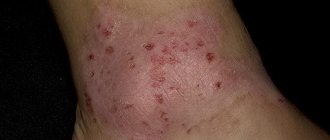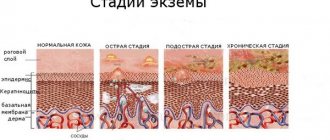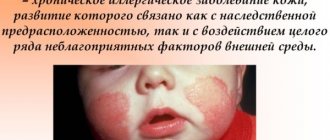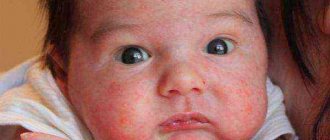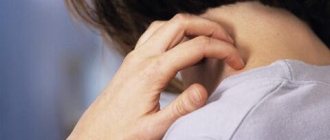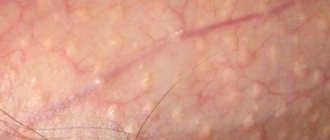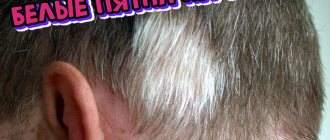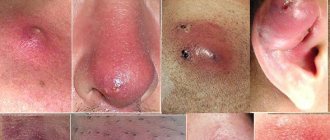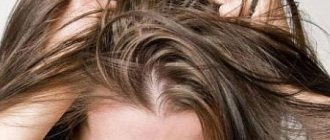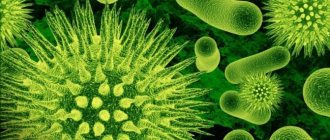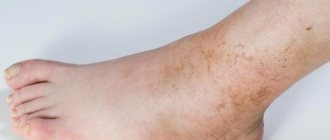Scalp dermatitis is a common disease in which the epidermis becomes inflamed. This skin disease occurs in approximately every 20th person on the planet between the ages of 18 and 50. Seborrheic and atopic dermatitis of the scalp are most often diagnosed. They are triggered by different factors, they have different symptoms, and the treatment is therefore different.
Symptoms
Seborrheic dermatitis on the head is manifested by the following symptoms:
- intense itching;
- the appearance of red spots that rapidly increase in size and have blurred boundaries;
- the skin is dry, tight, and very flaky.
Atopic dermatitis on the scalp has slightly different symptoms:
- the skin begins to itch, sometimes long before the rash appears;
- the appearance of dark scarlet skin scales;
- In addition to the head, the rash covers the face and body;
- In women, the décolleté area often turns red;
- in some cases, blisters form on the reddened areas, which later become covered with crusts.
Allergic type of dermatitis
Allergic dermatitis can appear due to the following reasons:
- Incorrectly selected or low-quality shampoo, conditioner and other hair care products.
- Hats that are made of low-quality material.
- Food allergies: most often to citrus fruits, exotic fruits, chocolate, as well as fish and seafood.
- Frequent stress and nervous tension can cause atopic dermatitis on the head.
- Long-term treatment with antibiotics and potent drugs.
And if in an adult the causes of the occurrence are very easy to determine, then in a child dermatitis may appear due to frequent washing with water or after sweating, since the skin is very sensitive and delicate.
Dermatitis can also be congenital; in such cases, children experience rashes not only on the scalp, but throughout the body.
Allergic dermatitis can be diagnosed only after a detailed examination of the skin. And the treatment itself should be prescribed by a dermatologist or allergist. To confirm the diagnosis, it is necessary to take tests and samples.
Allergic dermatitis on the head should be distinguished from lichen, psoriasis and seborrhea. In addition to performing skin tests, it is worth paying attention to the state of the hormonal system, the state of the immune system, and also conduct research for the presence of fungus.
The development of dermatitis on the head may indicate the presence of serious health problems; you should not self-medicate, but immediately go to the clinic.
Causes
The skin serves as a kind of barrier that blocks the path of pathogenic microorganisms. Sometimes the protection weakens, bacteria and fungi begin to actively multiply. Factors influencing the development of scalp dermatitis:
- Genetic predisposition.
- Chronic gastritis, colitis, dysbacteriosis and other gastrointestinal diseases.
- Disruptions in the endocrine system.
- Hormonal imbalance. When the amount of androgens in the blood increases, the production of sebaceous secretions increases. Then inflammation of the skin area occurs.
- Chronic foci of infection that form in the body.
- Weakened immunity. Due to a deficiency of vitamins and microelements and frequent colds, the protection of the scalp is weakened.
- Abrupt change in climatic zones.
- Neglect of personal hygiene rules.
- Sunburn, exposure to radiation.
- Wearing synthetic hats.
- The use of shampoos, gels and balms that have an aggressive effect on the skin.
- Diseases of a neurological and mental nature.
Treatment
The main task is not to delay a visit to a dermatologist.
Let's consider conservative therapy and folk remedies for dermatitis.
Drug therapy
Only a dermatologist has the right to prescribe treatment, taking into account the characteristics of the patient’s body and the degree of the disease. First you need to identify the provoking factor and symptoms. Then you may need to visit a gastroenterologist and neurologist. Treatment of scalp dermatitis involves:
- hormonal drugs;
- the use of creams and lotions containing active substances that quickly combat fungi;
- shampoos for scalp diseases with selenium, zinc, salicylic acid;
- taking vitamin and mineral complexes;
- antiallergic medications.
In addition, you can use darsonval, a device that eliminates itching and flaking, improves blood supply and the condition of the epidermis.
Treatment with ointment and cream
Treatment of skin dermatitis requires an integrated approach. The most effective shampoos are Cycloperix and Ketocotonazole. It is also advisable to use the following means:
- Hydrocortisone ointment - used for extensive lesions of the scalp. Prevents the development of fungi and accelerates recovery. Apply twice a day. You cannot use the medicine for a long time due to the high content of hormones.
- Lamisil is an antifungal drug that eliminates pathogens, relieves inflammation, and has an exfoliating effect. The ointment is gently rubbed onto the affected areas of the skin 2 times a day.
- Skin-scape is a cream-gel used mainly for early manifestations of dermatitis in the scalp area. Contains zinc, which relieves irritation and has a calming effect.
As an aid, the doctor may prescribe the use of immunomodulators. They reduce inflammation and have an antibacterial effect.
Pills
Tablet medications are prescribed for severe forms of the disease to relieve pain, eliminate large lesions of the skin and prevent re-infection. The most effective means are:
- Cetrin;
- Desal;
- Zyrtec;
- Zodak.
Potent prescription drugs include Flumethasone, Prednisolone, and Dexamethasone. They quickly eliminate the fungus and relieve symptoms. As a rule, they are taken in short courses. The doctor may also prescribe medications to improve bowel function, vitamins and minerals.
ethnoscience
Now let's look at how to get rid of dermatitis on the head using traditional methods. The most effective means:
- To eliminate dryness and flaking, use a cedar mask. Cedar oil is mixed with vodka and strong tea and rubbed into the epidermis. An hour after absorption, wash your hair. The procedure is carried out three times a week. It eliminates not only dandruff, but also redness.
- In the fight against dry dermatitis, use sea buckthorn pomace mixed with olive oil and heated in a water bath. The composition is rubbed into the hair roots twice a week for a month. It nourishes the skin with vitamins, reduces dryness, eliminates itching and redness.
- A decoction of oak bark helps eliminate oiliness and redness. Oak bark is mixed with a liter of water and infused. After washing, your hair should be rinsed with the resulting decoction.
- Meadowsweet root has an excellent antibacterial effect. To prepare the medicine, 100 g of finely chopped root is poured with boiling water, then left for 5 hours. The head is washed with the mixture three times a week. The result is noticeable after 15 applications. Redness disappears, itching and flaking are reduced.
- Seborrhea can be treated with garlic and onion, grated together. The mixture is used separately in the form of lotions or diluted with burdock oil. These masks are washed off with shampoo after 30 minutes.
It must be remembered that traditional methods of treatment can only be used as a supplement to the main therapy.
The use of folk remedies can speed up recovery.
Seborrheic dermatitis in children
Seborrheic dermatitis is an inflammatory skin reaction to exposure to various irritants.
The baby’s very delicate and sensitive skin, especially in the first months of life, reacts especially painfully, and most often an allergic reaction appears on the scalp, face (eyebrows, cheeks, ears are affected) or the upper part of the body, that is, in those places , where there is a large accumulation of sebaceous glands.
Parents often get scared when they notice a so-called seborrheic crust on their child’s head. Yes, the appearance of the yellow-brown film that forms as a result of the accumulation of scales on the body of a newborn does not look the best, but you should not take any action without consulting a doctor. Proper and competent care will help cope with this problem.
Seborrheic dermatitis in children on the face, head, buttocks: causes
The main cause of the inflammatory process is the activation of an opportunistic fungus under conditions favorable for its reproduction and the formation of toxic products of its vital activity. Many believe that it develops under the influence of internal and external reasons.
Internal factors include:
- disruptions in the functioning of the nervous system (stress or depression);
- weakened immunity (frequent ARVI, malnutrition, lack of sleep);
- problems with the endocrine system;
- hormonal surges in the body;
- great physical activity.
There are also external factors that contribute to the development of the disease. It may be due to genetic predisposition. Most often, children who have relatives with this type of disease suffer from this disease. The most dangerous is congenital seborrheic dermatitis, because it is practically incurable.
External causes also include: harmful effects of the external environment on the body, excessive sweating and even the use of alkaline detergents, which can become an additional irritant.
Seborrheic dermatitis in children under one year of age
Seborrhea occurs in almost 30% of children under the age of one year. As a rule, rashes in infants form on the scalp and hip area. Despite the fact that redness appears on the skin, the baby can play calmly and not notice anything. Such symptoms are not dangerous for him.
If this disease is detected in your child, you must carefully observe his personal hygiene. To remove a crust on your head, you need to thoroughly wash (soak) it, and only then comb it easily with a soft brush or washcloth.
A very effective method using baby or olive oil: rub it into problem areas at night, and in the morning you can easily wipe off the scales with a napkin and rinse the treated parts of the body.
For prevention, you can add decoctions of medicinal and antiseptic herbs, such as chamomile and string, to bathing baths.
In most cases, seborrhea in children under one year of age goes away without drug treatment.
Do not forget that various complications are possible. If the dermatitis has become inflammatory in nature or an infection has occurred, you should consult a doctor who will prescribe appropriate treatment.
Seborrheic dermatitis or psoriasis: differences
Psoriasis and seborrheic dermatitis are diseases whose symptoms are very similar, but at the same time have their differences. They are equally accompanied by itching, redness of the skin, and the appearance of scales. But still, they differ visually in their structure, as well as in the places of manifestation on the child’s body.
With seborrheic dermatitis, the foci of inflammation are yellow or completely white. The silvery color of damaged skin is a symptom of psoriasis. Seborrhea usually appears on the scalp, while psoriasis spreads to the back, elbows, knees and chest.
Psoriasis is not only a skin disease; it can appear as a result of disruption of the pancreas, stomach, and liver.
Both of these diseases are not contagious to others.
How to treat seborrheic dermatitis in a child: Komarovsky
Dear doctor Evgeniy Komarovsky considers the environment in which children live to be the main cause of this disease. Therefore, it is necessary to strictly observe the temperature regime and control the level of air humidity in the rooms where the baby is. You should not dress your child very warmly, as excessive sweating leads to a number of skin diseases.
The food should be satisfying, and the portions eaten should be appropriate for the child’s age. Overfeeding makes it difficult for the stomach to function and negatively affects the condition of the skin.
To effectively treat seborrhea, when bathing a child, you need to use boiled water that does not contain bleach.
Folk remedies
The disease does not always require drug treatment. Often traditional medicine helps to quickly get rid of the symptoms of an illness.
It is recommended to rub warm burdock oil into the scalp two or three times a week and wrap your hair in a towel for 30 minutes. Then wash off the oil with warm water and rinse well with a decoction of medicinal herbs (calendula flowers or young plantain leaves).
Chamomile decoction has wound-healing properties, soothes itching, and perfectly relieves inflammatory processes. To treat seborrheic dermatitis, traditional medicine also advises gently wiping the affected areas with a cotton swab every day:
- a decoction of calendula and chamomile flowers;
- fresh juice from Kalanchoe or aloe leaves;
- decoction of oak bark with the addition of a teaspoon of honey.
As a preventive measure and treatment, it is necessary to wipe the damaged areas of the skin every day with an alcohol tincture of calendula flowers, alternating it with a decoction of St. John's wort.
Especially for nashidetki.net - Victoria Krasnova
Source: https://nashidetki.net/zdorove-rebenka/seborejnyj-dermatit-u-detej.html
Proper nutrition for dermatitis on the head
During the treatment of scalp dermatitis, the following should be excluded:
- bitter foods;
- sauces, marinades;
- smoked products;
- alcohol;
- cakes;
- citrus;
- nuts;
- fried, fatty;
- sweet soda;
- honey.
With dermatitis, it is important to adhere to a certain diet.
Try to eat lean meats (chicken, veal), sunflower and olive oils, berries, dairy products, low-fat cheeses, and baked vegetables. You need to drink 2 liters of clean water per day.
Diet
Drug treatment of scalp dermatitis must be supplemented with a therapeutic diet. It is recommended to exclude from the diet:
- sugar, confectionery, sweet baked goods;
- chocolate and other foods and drinks containing caffeine;
- fast food;
- mushrooms;
- citrus fruits;
- strawberries;
- fish caviar;
- mushrooms;
- cow's milk (if the child has dermatitis).
It is also recommended to limit the consumption of fatty, smoked, salty foods, preserves and marinades.
- The basis of the daily diet should be:
- dietary meat (chicken, turkey, rabbit, beef);
- vegetables (pumpkin and zucchini are especially useful);
- porridge;
- fermented milk products (cottage cheese, kefir, yogurt, sour cream), low-fat cheese;
- fresh berries;
- fresh juices, compotes, fruit drinks, herbal teas.
In atopic inflammation, it is especially important to monitor your diet and avoid consuming allergenic foods.
Prevention
To prevent dermatitis, you need to maintain hygiene, strengthen the immune system through walks in the open air, vitamin and mineral complexes. Nutrition for dermatitis plays a key role, so try to exclude spicy, fried, fatty foods, and preservatives. It is recommended to give preference to cosmetics, hygiene products and household chemicals only from reliable brands.
Maintaining personal hygiene is one of the measures to prevent dermatitis.
Timely therapy and strict adherence to the doctor’s recommendations will quickly and effectively eliminate scalp dermatitis.
